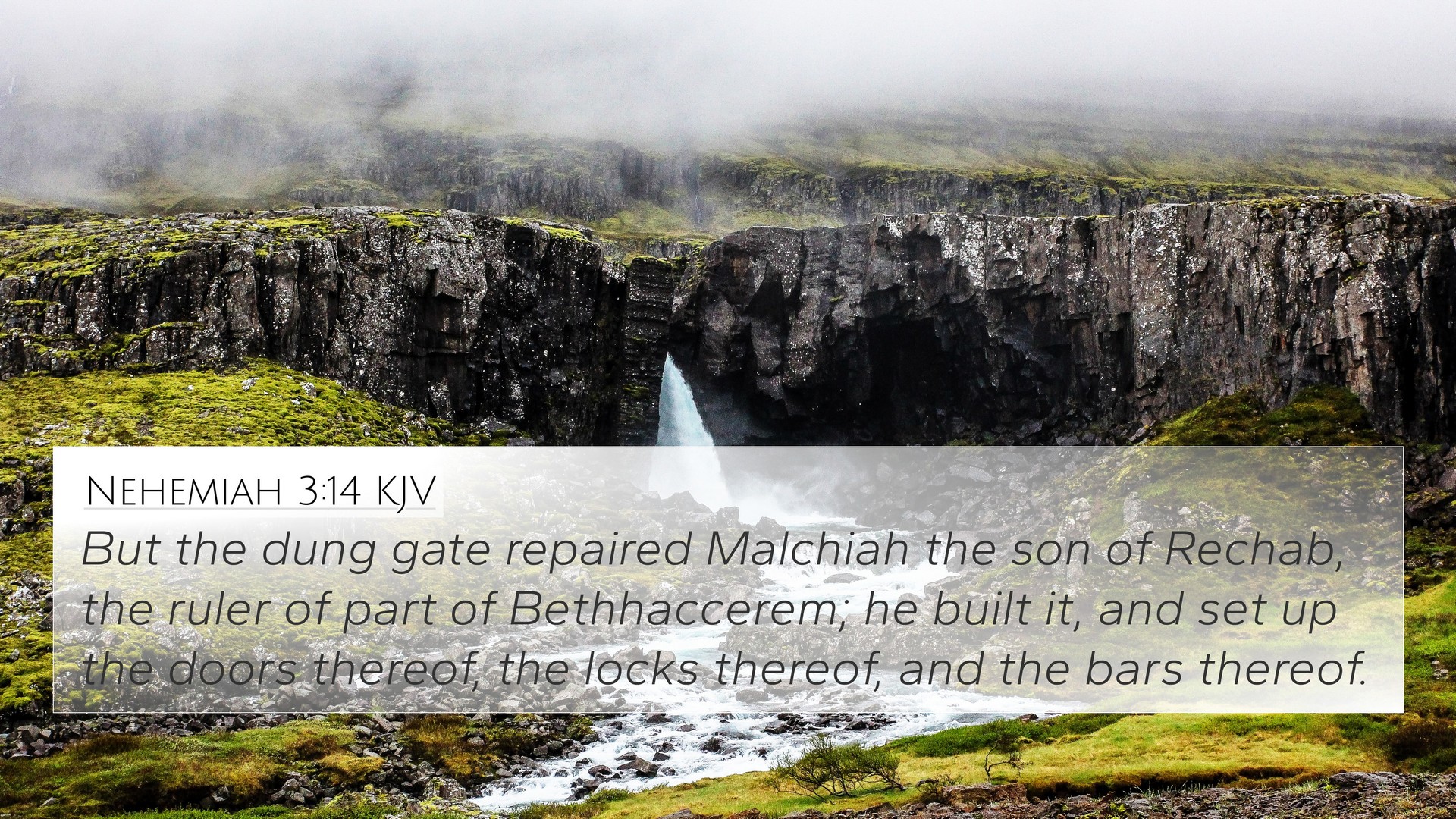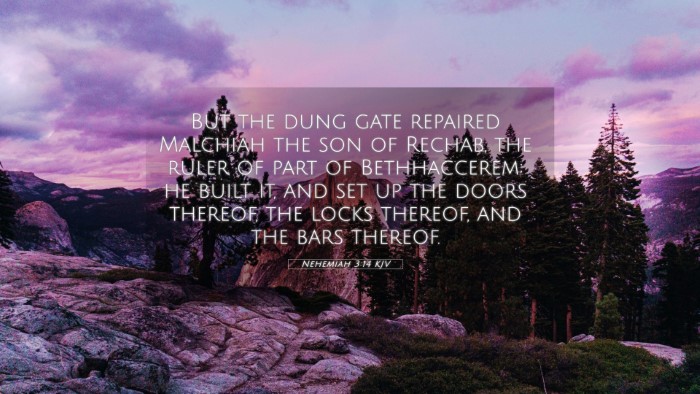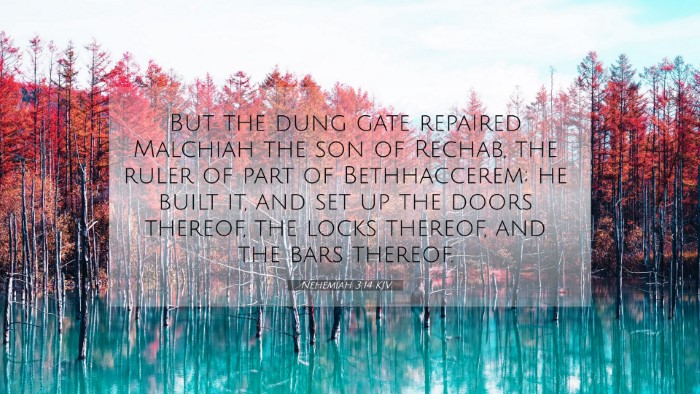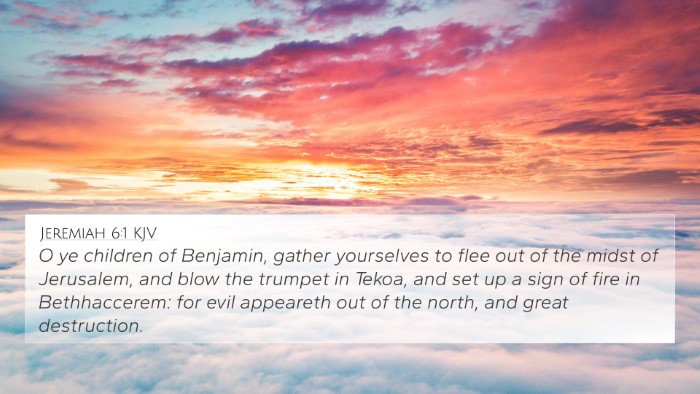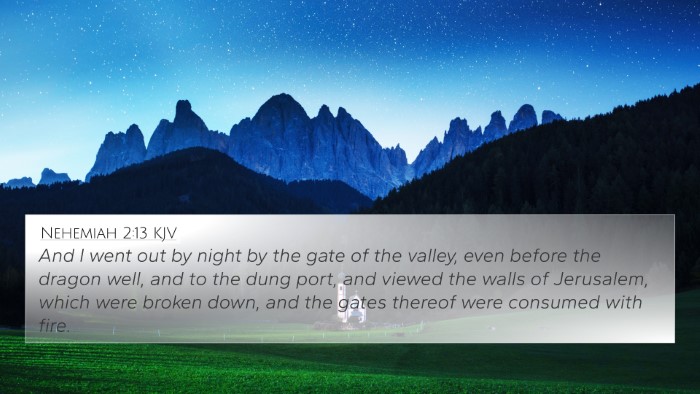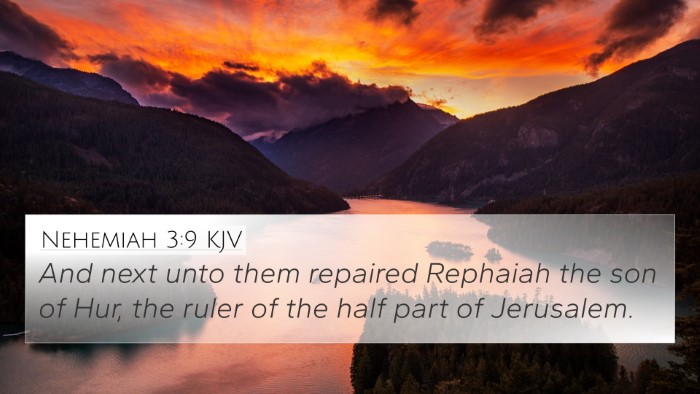Understanding Nehemiah 3:14
Nehemiah 3:14 states:
"But the dung gate repaired Malchiah the son of Rechab, the ruler of part of Beth-haccerem; he built it and set up the doors thereof, the locks thereof, and the bars thereof."
Summary of Meaning
This verse highlights the efforts of Malchiah in repairing the dung gate of Jerusalem. This gate symbolizes the place where refuse was taken, both literally and metaphorically representing the purification process needed for the city and its people. Malchiah, identified as a ruler from Beth-haccerem, signifies the involvement of local leaders in the rebuilding efforts during the post-exilic period.
Commentary Insights
- Matthew Henry: He emphasizes the significance of the dung gate as a necessary part of the city's structure, illustrating that even the less glamorous tasks are essential in the work of rebuilding. Henry notes how every task, no matter how small, contributes to the larger purpose of restoration and purification.
- Albert Barnes: Barnes discusses the role of Malchiah as a representative of civic leadership. He points out that the repairs signify not just physical restoration, but also moral and social restoration for the people of Jerusalem. The act of repairing the dung gate speaks to the acknowledgment of the city's past shame and a commitment to moving forward.
- Adam Clarke: Clarke elucidates that the dung gate's repair connects to the broader theme of cleansing and holiness. By restoring this gate, it symbolizes the removal of impurities from the city, paralleling the spiritual renewal that Nehemiah sought among the people, linking it to themes found throughout scripture concerning purification and sanctification.
Cross-References
This verse connects with several other Biblical texts that explore themes of restoration, leadership, and purification:
- Isaiah 52:11: "Depart ye, depart ye, go ye out from thence, touch no unclean thing; go ye out of the midst of her; be ye clean, that bear the vessels of the Lord." - A call to purity.
- Ezekiel 36:25: "Then will I sprinkle clean water upon you, and ye shall be clean: from all your filthiness, and from all your idols, will I cleanse you." - The theme of cleansing is evident.
- 2 Corinthians 7:1: "Having therefore these promises, dearly beloved, let us cleanse ourselves from all filthiness of the flesh and spirit, perfecting holiness in the fear of God." - Calls for personal and communal purity.
- Nehemiah 2:17: "Then said I unto them, Ye see the distress that we are in, how Jerusalem lieth waste, and the gates thereof are burned with fire: come, and let us build up the wall of Jerusalem, that we be no more a reproach." - Context of rebuilding and leadership.
- Psalm 51:7: "Purge me with hyssop, and I shall be clean: wash me, and I shall be whiter than snow." - A plea for purification.
- Proverbs 14:4: "Where no oxen are, the crib is clean: but much increase is by the strength of the ox." - Acknowledges the necessity of sometimes dealing with the 'dirty work' of life.
- Hebrews 9:14: "How much more shall the blood of Christ, who through the eternal Spirit offered himself without spot to God, purge your conscience from dead works to serve the living God?" - The ultimate purification through Christ.
Thematic Connections
Nehemiah 3:14 can be analyzed through various themes emerging from the verse and cross-references:
- Restoration: The rebuilding of the dung gate symbolizes spiritual and communal restoration following exile.
- Leadership: Malchiah's role as a leader highlights the importance of local governance in communal efforts.
- Purification: The act of repairing the dung gate draws attention to the need for cleansing from past sins and impurities.
- Community Involvement: The collaborative effort in rebuilding illustrates the importance of communal responsibility.
Tools for Bible Cross-Referencing
Engaging with Nehemiah 3:14 and its connections can be enhanced by utilizing various tools for Bible cross-referencing:
- Bible Concordance: A comprehensive index that allows you to find key terms and their occurrences throughout the Scripture.
- Bible Cross-reference Guide: Resources designed to show how different verses interlink thematically or contextually.
- Cross-reference Bible Study: Methods that encourage deeper investigation into linked verses.
- Comprehensive Bible Cross-reference Materials: Delve into annotated Bibles equipped with references for thorough study.
Conclusion
Nehemiah 3:14 not only illustrates a physical act of rebuilding but encapsulates deep spiritual significance concerning purity, community, and leadership. As readers explore its connection to other Scriptures, they may gain further insight into the overarching narrative of restoration seen throughout the Bible. Creative engagement with the text through cross-referencing can yield profound understanding and application in spiritual life.
